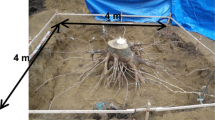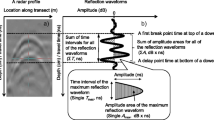Abstract
Aims
Tree roots in forest soils can be detected using nondestructive ground-penetrating radar (GPR). However, few studies have investigated root detection frequency; i.e., how many and which roots are identified in a radar profile out of the total quantity of roots present in a forest stand. The objective of this study was to quantify root detection frequency and uncertainty, including relationships between root detection and radar parameters using 1.5 GHz GPR in a Pinus thunbergii forest on sandy soils.
Methods
We compared the vertical distribution of 829 excavated roots with distributions identified visually in radar profiles using GPR on 17 transects.
Results
The detection frequency for number of roots less than 1.0 cm in diameter was only 6.6 %, but 54 % of roots that were larger than 1.0 cm were detected. Roots larger than 2.0 cm were identified with less frequency by GPR at deeper depths (20–30 cm) than were shallower roots.
Conclusion
Our study indicates that GPR methods estimate root biomass to be 68 % of the excavated root biomass and that the detection frequency for number of roots in radar profiles using GPR is related to root biomass, although there is uncertainty in the attenuation of radar waves with depth, soil water condition and root orientation.






Similar content being viewed by others
Abbreviations
- GPR:
-
Ground-penetrating radar
- SE:
-
Standard error
References
Amato M, Basso B, Celano G, Bitella G, Morelli G, Rossi R (2008) In situ detection of tree root distribution and biomass by multi-electrode resistivity imaging. Tree Physiol 28:1441–1448. doi:10.1093/treephs/28.10.1441
Barton CVM, Montagu KD (2004) Detection of tree roots and determination of root diameters by ground penetrating radar under optimal condition. Tree Physiol 24:1323–1331. doi:10.1093/treephs/24.12.1323
Brown MB, Forsythe AB (1974) Robust tests for the equality of variances. J Am Statis Asso 69:364–367. doi:10.1080/01621459.1974.10482955
Brunner I, Godbold DL (2007) Tree roots in a changing world. J Forest Res 12:78–82. doi:20.1007/s103 10-006-0261-4
Butnor JR, Doolittle JA, Kress L, Cohen S, Johnsen KH (2001) Use of ground-penetrating radar to study tree roots in the southeastern United States. Tree Physiol 21:1269–1278. doi:10.1093/treephs/21.17.1269
Butnor JR, Doolittle JA, Johnsen KH, Samuelson L, Stokes T, Kress L (2003) Utility of ground-penetrating radar as a root biomass survey tool in forest systems. Soil Sci Soc Am J 67:1607–1615. doi:10.2136/sssaj2003.1607
Butnor JR, Barton C, Day FP, Johnsen KH, Mucciardi AN, Schroeder R, Stover D (2011) Using ground penetrating radar to detect tree roots and estimate biomass. In: Mancuso S (ed) Measuring roots, an updated approach. Springer, Heidelberg, pp 213–245
Čermák J, Hruška J, Martinková M, Prax A (2000) Urban tree root systems and their survival near houses analyzed using ground penetrating radar and sap flow techniques. Plant Soil 219:103–116. doi:10.1023/A:1004736310417
Cox KD, Scherm H, Serman N (2005) Ground-penetrating radar to detect and quantify residual root fragments following peach orchard cleaning. Hort Technol 15:600–607
Chow TL, Rees HW (1989) Identification of subsurface drain locations with ground-penetrating radar. Can J Soil Sci 69:223–234. doi:10.4141/cjss89-023
Cui XH, Shen JS, Cao X, Chen XH, Zhu XL (2011) Modeling tree root diameter and biomass by ground-penetrating radar. Sci China Earth Sci 54:711–719. doi:10/1007s11430-010-413-z
Dannoura M, Hirano Y, Igarashi T, Ishii M, Aono K, Yamase K, Kanazawa Y (2008) Detection of Cryptomeria japonica roots with ground penetrating radar. Plant Biosyst 142:375–380. doi:10.1080/11263500802150951
Douglas GB, McIvor IR, Potter JF, Foote LG (2010) Root distribution of poplar at varying densities on pastoral hill country. Plant Soil 333:147–161. doi:10.1007/s11104-010-0331-4
Fujita E, Nakata M (2001) Changes in vegetation and soil properties caused by mixture of deciduous broad-leaved trees in Japanese black pine (Pinus thunbergii Parl.) stand at coastal sand dune: a case study in Kaetsu district, Niigata Prefecture. J Jpn For Soc 83:84–92 (in Japanese with English summary)
Futai K (2003) Role of asymptomatic carrier trees in epidemic spread of pine wilt disease. J Forest Res 8:253–260. doi:10.1007/s10310-003-0034-2
Government of Japan (2008) Report on Japan’s supplementary information on LULUCF activities under article 3, paragraphs 3 and 4 of the Kyoto Protocol
Hagrey SA (2007) Geophysical imaging of root-zone, trunk, and moisture heterogeneity. J Exp Bot 58:839–854. doi:10.1007/s10310-006-0263-2
Hirano Y, Mizoguchi T, Brunner I (2007) Root parameters of forest trees as sensitive indicators of acidifying pollutants—a review of research of Japanese forest trees. J Forest Res 12:134–142. doi:10.1007/s10310-006-0263-2
Hirano Y, Dannoura M, Aono K, Igarashi T, Ishii M, Yamase K, Makita N, Kanazawa Y (2009) Limiting factors in the detection of tree roots using ground-penetrating radar. Plant Soil 319:15–24. doi:10.1007/s11104-008-9845-4
Hruška J, Čermák J, Sustek S (1999) Mapping tree root systems with ground-penetrating radar. Tree Physiol 19:125–130. doi:10:1093/treephs/19.2.125
Makita N, Hirano Y, Dannoura M, Yamase K, Aono K, Igarashi T, Ishii M, Kanazawa Y (2009) Biomass and distribution of roots in a Pinus densiflora forest estimated by methods of destructive block sampling, trench wall and ground penetrating radar. Root Res 18:39–47 (in Japanese with English summary)
Sakai Y, Takahashi M, Tanaka N (2007) Root biomass and distribution of a Picea-Abies stand and a Larix-Betula stand in pumiceous Entisols in Japan. J Forest Res 12:120–125. doi:10.1007/s10310-006-0270-3
Soil Survey Staff (1999) Soil taxonomy, 2nd edn. A basic system of soil classification for making and interpreting soil surveys. USDA Agri Handbook No.436. Washington, D.C.
StatSoft Japan Inc (2005) STATISTICA 06J, Tokyo, Japan
Stokes A, Fourcaud T, Hruška J, Čermák J, Nadyezdhina N, Nadyezhdin V, Praus L (2002) An evaluation of different methods to investigate root system architecture of urban trees in situ: I. Ground-penetrating radar. J Arboricult 28:2–10
Stover DB, Day FP, Butnor JR, Drake BG (2007) Effect of elevated CO2 on coarse root biomass in Florida scrub detected by ground-penetrating radar. Ecology 88:1328–1334. doi:10.1890/06-0989
Tobin B, Čermák J, Chiatante D, Danjon F, Di Iorio A, Dupuy L, Eshel A, Jourdan C, Kalliokoski T, Laiho R, Nadezhdina N, Nicoll B, Pages L, Silva J, Spanos I (2007) Towards developmental modeling of tree root systems. Plant Biosyst 141:481–501. doi:10.1080/11263500701626283
Yanai RD, Park BB, Hamburg SP (2006) The vertical and horizontal distribution of roots in northern hardwood stands of varying age. Can J For Res 36:450–459. doi:10.1139/x05-254
Zenone T, Morelli G, Teobaldelli M, Fischanger F, Matteucci M, Sordini M, Armani A, Ferrè C, Chiti T, Seufert G (2008) Preliminary use of ground-penetrating radar and electrical resistivity tomography to study tree roots in pine forests and poplar plantations. Funct Plant Biol 35:1047–1058. doi:org/10.1071/FP08062
Acknowledgments
We greatly acknowledge the editor and two anonymous reviewers for their constructive comments on an earlier version of the manuscript. This study was supported by Grands-in-Aid for Scientific Research from the Ministry of Education, Culture, Sports, Science and Technology, Japan (Nos. 18380095, 22380090). We thank the National Awaji Youth Friendship Center for permission to use the experimental field, and S. Asano-Tsuji, T. Ikeda and D. Nomoto for help with the field experiment.
Author information
Authors and Affiliations
Corresponding author
Additional information
Responsible Editor: Alain Pierret.
Rights and permissions
About this article
Cite this article
Hirano, Y., Yamamoto, R., Dannoura, M. et al. Detection frequency of Pinus thunbergii roots by ground-penetrating radar is related to root biomass. Plant Soil 360, 363–373 (2012). https://doi.org/10.1007/s11104-012-1252-1
Received:
Accepted:
Published:
Issue Date:
DOI: https://doi.org/10.1007/s11104-012-1252-1




